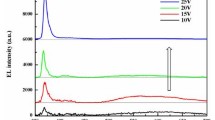Abstract
GaN:Zn//Al2O3 electroluminescent devices have been obtained with a wide range of emitted colours (blue, green, yellow and red) ; theses devices have high potential since external quantum efficiencies greater than 1 % and power efficiencies of about 10−3 have been reported. On the other hand, from the literature it seems that each colour is obtained randomly, since apparently the same method of preparation is used. We show that the properties of GaN:Zn (conductivity type, cathodoluminescence (peaks and efficiency)) can not be related uniquely to the partial pressure of zinc during the growth, but it is also necessary to take into account the partial pressure of HCl and the thickness of the π layer in order to obtain a satisfactory representation of these properties. From this knowledge, one can deduce the different parameters for growing layers for devices and control their properties. The device fabrication consists of the deposition of a Zn doped thin layer, which is nearly insulating but with p tendency (π layer), onto a Zn doped n type layer. It is demonstrated that the characteristics of the devices (I(V) curves, electroluminescent peaks and efficiencies are related to the characteristics of the π layer and on the transition from n to π. Blue LEDS with characteristics very similar to p-n junction characteristics have been obtained.
Similar content being viewed by others
References
J.I. Pankove, J. Lumin.7, 114 (1973).
J.I. Pankove, RCA Rev.34, 336 (1973).
J.I. Pankove, Phys. Rev. Lett.34,809 (1975).
J.I. Pankove, IEEE Transaction on Electron DeviceED22, 721 (1975).
G. Jacob, P. Madar and J. Hallais, Mat. Res. Bull. 11, 445 (1976).
G. Jacob and D. Bois, Appl. Phys. Lett.30, 412 (1977).
A. Shintani and S. Minagawa, J. Electrochem. Soc.123, 1725 (1976).
A. Shintani and S. Minagawa, J. Appl. Phys.48 1522 (1977).
M. Ilegems, R. Dingle and R.A. Logan, J. Appl. Phys.13, 373 (1975).
E. Ejder and H.G. Grimmeiss, Appl. Phys.5, 275 (1974).
A.N. Vasilishchev, L.N. Mikhailov, V.G. Sidorov, M.D. Shagalov and Y.K. Shalabutov, Sov. Phys. Semi-cond.9, 1189 (1975).
S.M. Sze, Physics of Semiconductors Devices, p. 496, Wileyand Sons, New York (1969).
J. Frenkel, Techn. Phys. USSR5, 685 (1938).
R.M. Hill, Thin Solid Films12, 367 (1972).
G. Jacob, M. Boulou and D. Bois, to be published in Journal of Luminescence.
J.I. Pankove and M.A. Lampert, Phys. Rev. Lett.33, 361 (1974).
S.M. Sze, see Ref. 12, page 94.
J.I. Pankove, S. Bloom and G. Harbeke, RCA Rev.36, 163 (1975).
Author information
Authors and Affiliations
Additional information
This work has been supported by DGRST (Délégation a la Recherche Scientifique et Technique).
Rights and permissions
About this article
Cite this article
Jacob, G., Boulou, M., Furtado, M. et al. Gallium nitride emitting devices preparation and properties. J. Electron. Mater. 7, 499–514 (1978). https://doi.org/10.1007/BF02655414
Received:
Revised:
Issue Date:
DOI: https://doi.org/10.1007/BF02655414




